mojoreef
Just a reefer
I thought we could do a little write up on "How lighting effects corals" just to give folks a general idea on why corals need light and how different lighting effects your corals. So lets have at it!
So when one looks at corals and their colors we have to look at it in two separate sections, the first is not so much the coral but the zooxanthellae contained within them. The zoox are basically a form of algae called dinoflagellates (and yes the same kind as the nasty ones)
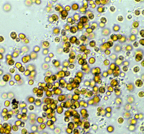
As we all know they perform a service to the coral by providing it with oxygen, glucose, glycerol and amino acids and also help the coral with getting rid of waste. They do this by creating the above mentioned as a result of their Photosynthesis process. (But this is a topic for another article. Since we are talking about colors lets go with that)
Within the zoox they contain a series of pigments; the main ones are chlorophyll which to our eyes look green. The next most dominant is carotenoid peridinin which to our eyes looks yellow. Now these pigments are basically chemical molecules that possess the ability to absorb visible light photons which are being supplied by your lighting systems. They then in turn provide the coral with the above materials.
So now we know what makes the zoox have color, basically a bunch of yellow pigments and a bunch of green pigments, well when you mix yellow and green what do you get?? Yep brown, and that’s why most corals are brown. No, this can vary based on the amount of zoox in the coral and in the amount of each type of pigment within them. So what does that mean?? Well it means that we can effect some changes. So if your tank has a lot of nutrients, yep the zoox algae will have a field day and its most likely they will be brown. But lighting can also play a role. Most of the chlorophyll pigments have a strong ability to gather light in the blue and violet range. The other more dominant pigment, carotenoid peridinin mostly absorbs blue light waves but does absorb violet and a tiny bit of green. So by choosing a particular bulb that puts out a particular light wave, you can make one or more of these pigments dominate and thus be more viable to us.
Ok so that is the basic concept of zoox coloration and how we can affect it, so let’s take a peek at the coral itself as we all like to have colorful corals.
So as we talked about above, the Zoox require light photons in order to live and in return supply the coral with the nutrients and so on it needs to live, so this is a pretty dramatic relationship. Now when we talk about coral pigmentation we have to look at it like they are farmers (as they really are). Pretty much everything the coral does color/pigment wise is to protect, enhance or accommodate the zoox within the coral tissue, so let’s look at some of this.
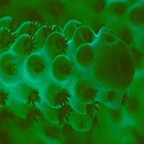
One of the main functions is protection. Zoox can be killed by UV radiation that the sun/our bulbs produce, so the coral has certain pigments that provide protection against this. Most of these are clear to our eye but mist all pigments contained within the coral does this to a point. But hey, clear is a boring color so lets look at some of the fun ones.
The vast majority of pigments within coral is pocilloporins and is categorized as either Brightly Colored Low Fluorescent Pocilloporins or as Highly Fluorescent Pocilloporins. These are the ones we see when we look at a coral and say wow look at the color!!
First we will look at Low Fluorescent Pocilloporins pigments. These pigments take light that is lower in the light spectrum, from UV to violets, (which protects the zoox) or within the zone of 400 to 620 nm absorb it within them and then convert that color (or fluoresce) to a color that the zoox can use in its process. We cannot see the colors that they absorb but we can see what they emit.
With Highly Fluorescent Pocilloporin pigments they also have the ability to absorb a particular color and then transmit a more useable color back to the zoox. They cover a different range of color waves coming in and produce much more fluoresce, so a lot of bang for your buck. What is also really neat about these is that they can work in what is called "chain linking". What this means is that one pigment takes a color, converts it to another, which is then taken by another pigment, and is then converted into something the zoox can use. They can basically take most all colors, and then continuously covert it through chaining a final product of light the zoox can use.
Well when you choose your bulbs you are going to dictate what the color of them is going to be and what the growth is going to be like (sps). So for growth zoox have chlorophyll pigment they have strong light absorbing capabilities within the violet/blue area of the light spectrum and can also absorb a significant amount of red light. They also have carotenoid peridinin pigment which absorbs blue light along with some violet and some green. Satisfy this and the coral will grow.
For color we have more ranges:
>Pocilloporin primarily absorbs green/yellow (550-600 nm) light along with some upper UV-A . it emits a orange/red
>highly fluorescent pocilloporins primarily absorbs light from 310 to 380 nm (UV-B and UV-A) and then fluoresces this as light from 400 to 470 nm (violet/blue).
>highly fluorescent pocilloporin primarily absorbs light from 380 to 470 nm (UV-A, violet and blue) and fluoresces light from 475 to 520 nm (blue and green).
>third type of highly fluorescent pocilloporin primarily absorbs light from 430 to 490 nm (violet and blue) and fluoresces light from 490 to 540 nm (green/yellow).
>Yellow fluorescing pocilloporin primarily absorbs light from 440 to 500 nm (blue) and fluoresces light from 520 to 620 nm (green, yellow and orange).
>Red/Orange Fluorescing pocilloporin that primarily absorbs light from 500 to 540 nm (green) and fluoresces light with wavelengths that are primarily orange to red.
Ok, so now we know what color we put in and what colors will give what results, so let’s translate that to bulbs.
Here is a 20000K radium wave plot 400 watt.
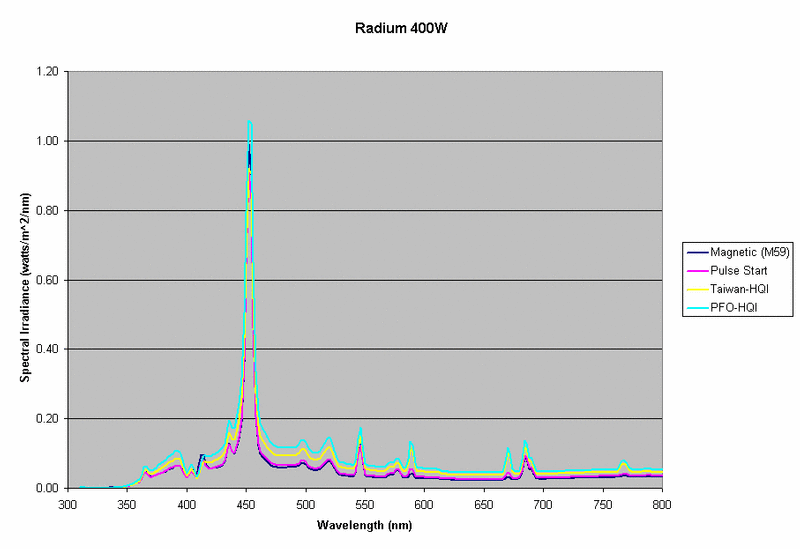
Looking at that, then translating into what we know. We could assume to get alot of of dark green, blues, some yellows and some deep reds. But for growth it doesn't have a lot of red, green or violet, so not a lot.
Now lets look at the 10000K ushio 400 watt
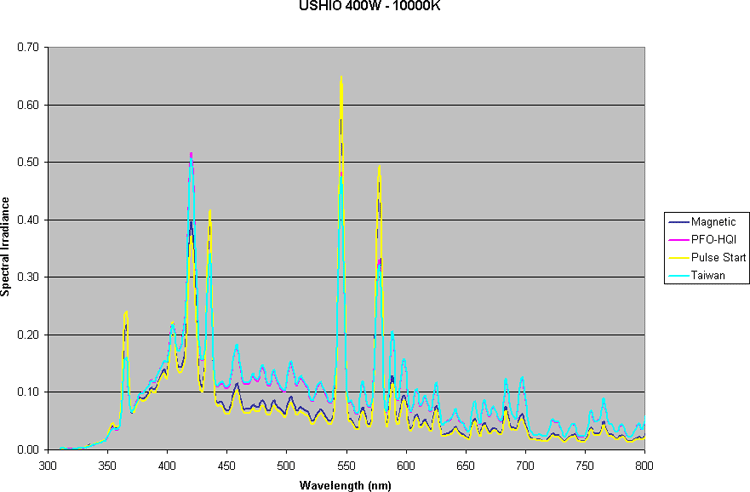
Looking at this we see good violet which translates to violet and blues, and strong 500 to 600 so good oranges, reds, greens etc...
Here are some more charts, you do the math,
here are a bunch of 400 watters
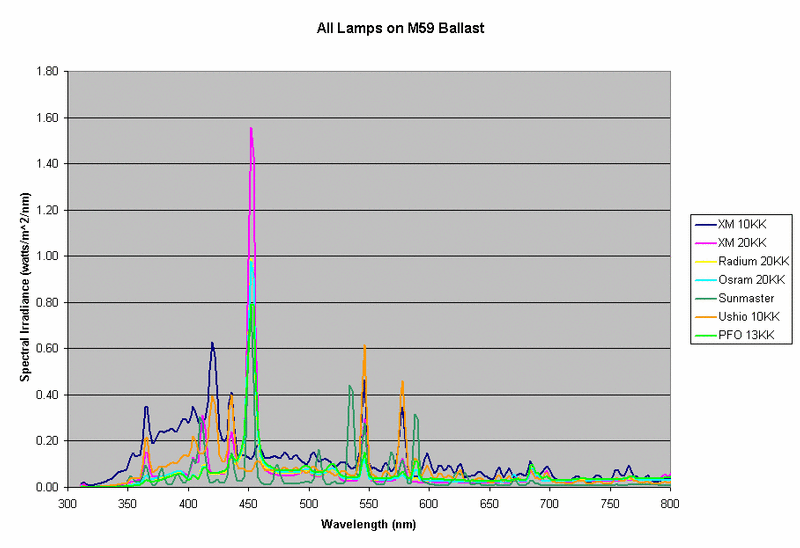
and some 250 watt de's
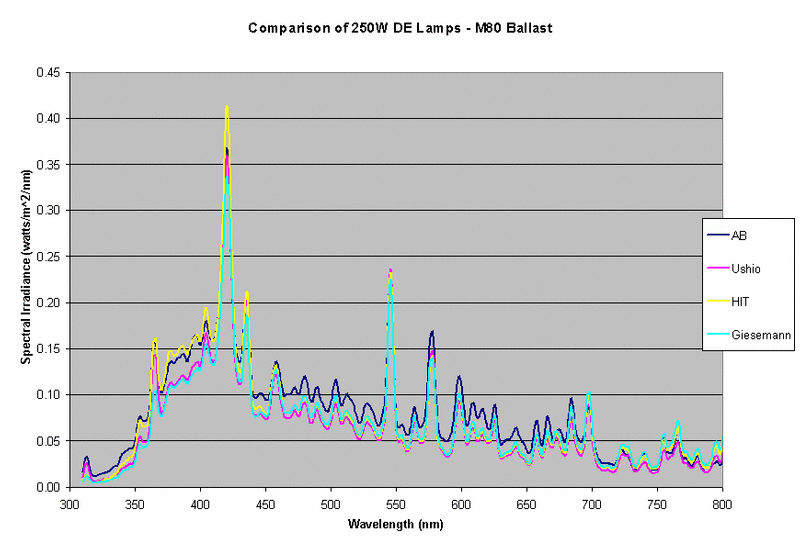
Please feel free to discuss
Mojo
So when one looks at corals and their colors we have to look at it in two separate sections, the first is not so much the coral but the zooxanthellae contained within them. The zoox are basically a form of algae called dinoflagellates (and yes the same kind as the nasty ones)

As we all know they perform a service to the coral by providing it with oxygen, glucose, glycerol and amino acids and also help the coral with getting rid of waste. They do this by creating the above mentioned as a result of their Photosynthesis process. (But this is a topic for another article. Since we are talking about colors lets go with that)
Within the zoox they contain a series of pigments; the main ones are chlorophyll which to our eyes look green. The next most dominant is carotenoid peridinin which to our eyes looks yellow. Now these pigments are basically chemical molecules that possess the ability to absorb visible light photons which are being supplied by your lighting systems. They then in turn provide the coral with the above materials.
So now we know what makes the zoox have color, basically a bunch of yellow pigments and a bunch of green pigments, well when you mix yellow and green what do you get?? Yep brown, and that’s why most corals are brown. No, this can vary based on the amount of zoox in the coral and in the amount of each type of pigment within them. So what does that mean?? Well it means that we can effect some changes. So if your tank has a lot of nutrients, yep the zoox algae will have a field day and its most likely they will be brown. But lighting can also play a role. Most of the chlorophyll pigments have a strong ability to gather light in the blue and violet range. The other more dominant pigment, carotenoid peridinin mostly absorbs blue light waves but does absorb violet and a tiny bit of green. So by choosing a particular bulb that puts out a particular light wave, you can make one or more of these pigments dominate and thus be more viable to us.
Ok so that is the basic concept of zoox coloration and how we can affect it, so let’s take a peek at the coral itself as we all like to have colorful corals.
So as we talked about above, the Zoox require light photons in order to live and in return supply the coral with the nutrients and so on it needs to live, so this is a pretty dramatic relationship. Now when we talk about coral pigmentation we have to look at it like they are farmers (as they really are). Pretty much everything the coral does color/pigment wise is to protect, enhance or accommodate the zoox within the coral tissue, so let’s look at some of this.

One of the main functions is protection. Zoox can be killed by UV radiation that the sun/our bulbs produce, so the coral has certain pigments that provide protection against this. Most of these are clear to our eye but mist all pigments contained within the coral does this to a point. But hey, clear is a boring color so lets look at some of the fun ones.
The vast majority of pigments within coral is pocilloporins and is categorized as either Brightly Colored Low Fluorescent Pocilloporins or as Highly Fluorescent Pocilloporins. These are the ones we see when we look at a coral and say wow look at the color!!
First we will look at Low Fluorescent Pocilloporins pigments. These pigments take light that is lower in the light spectrum, from UV to violets, (which protects the zoox) or within the zone of 400 to 620 nm absorb it within them and then convert that color (or fluoresce) to a color that the zoox can use in its process. We cannot see the colors that they absorb but we can see what they emit.
With Highly Fluorescent Pocilloporin pigments they also have the ability to absorb a particular color and then transmit a more useable color back to the zoox. They cover a different range of color waves coming in and produce much more fluoresce, so a lot of bang for your buck. What is also really neat about these is that they can work in what is called "chain linking". What this means is that one pigment takes a color, converts it to another, which is then taken by another pigment, and is then converted into something the zoox can use. They can basically take most all colors, and then continuously covert it through chaining a final product of light the zoox can use.
So what does all this mean??
Well when you choose your bulbs you are going to dictate what the color of them is going to be and what the growth is going to be like (sps). So for growth zoox have chlorophyll pigment they have strong light absorbing capabilities within the violet/blue area of the light spectrum and can also absorb a significant amount of red light. They also have carotenoid peridinin pigment which absorbs blue light along with some violet and some green. Satisfy this and the coral will grow.
For color we have more ranges:
>Pocilloporin primarily absorbs green/yellow (550-600 nm) light along with some upper UV-A . it emits a orange/red
>highly fluorescent pocilloporins primarily absorbs light from 310 to 380 nm (UV-B and UV-A) and then fluoresces this as light from 400 to 470 nm (violet/blue).
>highly fluorescent pocilloporin primarily absorbs light from 380 to 470 nm (UV-A, violet and blue) and fluoresces light from 475 to 520 nm (blue and green).
>third type of highly fluorescent pocilloporin primarily absorbs light from 430 to 490 nm (violet and blue) and fluoresces light from 490 to 540 nm (green/yellow).
>Yellow fluorescing pocilloporin primarily absorbs light from 440 to 500 nm (blue) and fluoresces light from 520 to 620 nm (green, yellow and orange).
>Red/Orange Fluorescing pocilloporin that primarily absorbs light from 500 to 540 nm (green) and fluoresces light with wavelengths that are primarily orange to red.
Ok, so now we know what color we put in and what colors will give what results, so let’s translate that to bulbs.
Here is a 20000K radium wave plot 400 watt.

Looking at that, then translating into what we know. We could assume to get alot of of dark green, blues, some yellows and some deep reds. But for growth it doesn't have a lot of red, green or violet, so not a lot.
Now lets look at the 10000K ushio 400 watt

Looking at this we see good violet which translates to violet and blues, and strong 500 to 600 so good oranges, reds, greens etc...
Here are some more charts, you do the math,
here are a bunch of 400 watters

and some 250 watt de's

Please feel free to discuss
Mojo
Last edited by a moderator:








 a great read...
a great read...